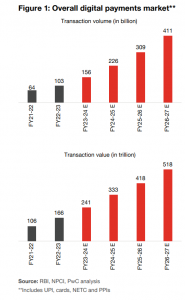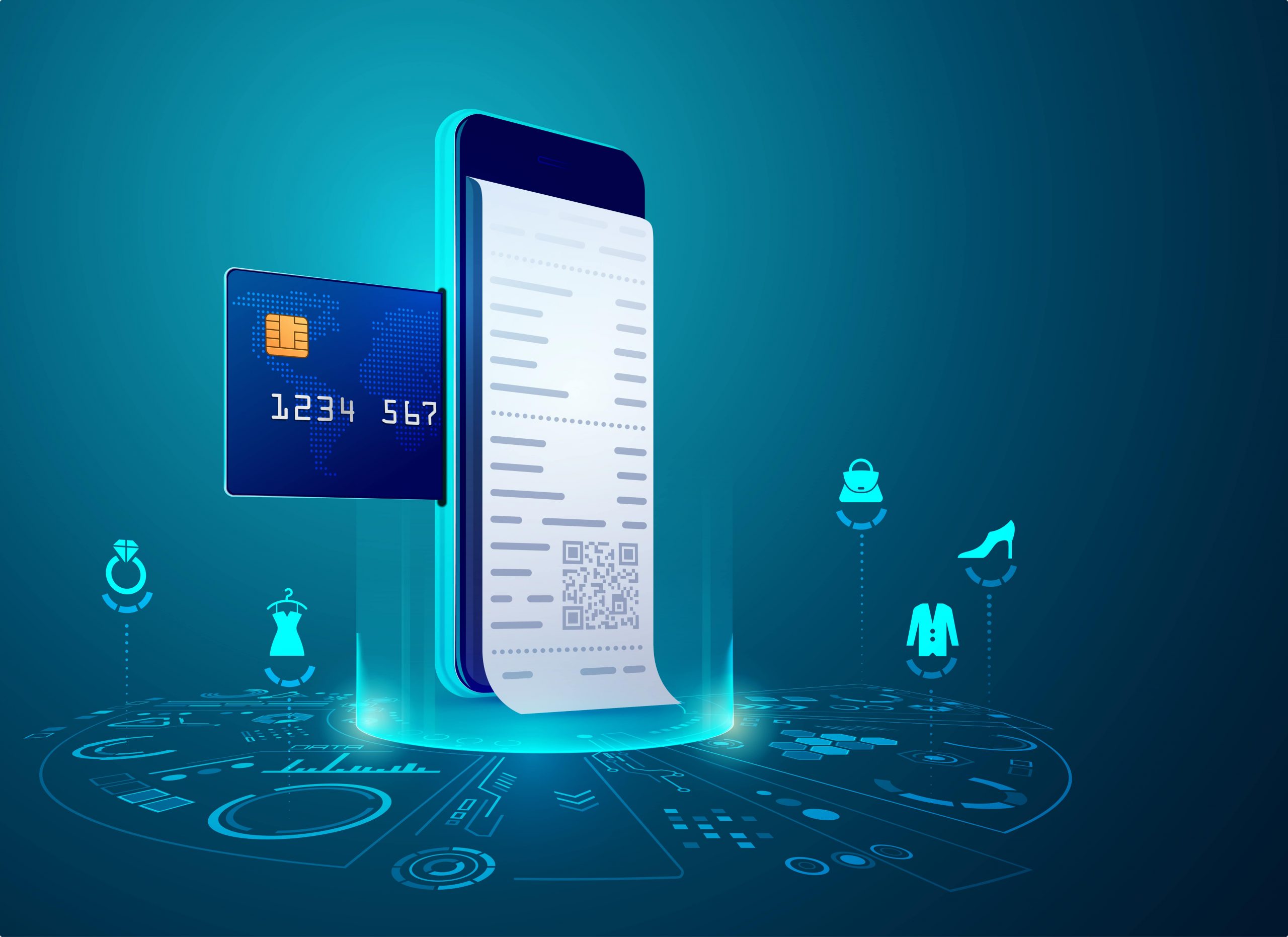India has made remarkable progress in digital payments adoption, setting a remarkable precedent for nations worldwide. At the core of this rapid transformation lies the belief that digital payments are a fundamental pillar of financial inclusivity and have the power of bringing diverse population-set into a well-structured financial ecosystem. In this sense, the impact of digital payments in India has been nothing short of groundbreaking. Consumers are adopting digital payments at an increasing rate, and India is poised for yet another boom in digital payments transactions thanks to ongoing innovations and the introduction of new use cases.
India’s digital payment journey
The trajectory of digital payments in India has been nothing short of astounding, marked by a staggering year-on-year transactional volume growth of 56% in the fiscal year 2022–2023, and this momentum is expected to quadruple by the fiscal year 2026–2027, as per a PwC report.
This meteoric rise can be attributed to a confluence of factors, including strategic policies enacted by the Government of India and the proactive role played by the Reserve Bank of India (RBI) in championing digital payments. Additionally, the emergence of dynamic FinTech innovations designed to enhance the user experience and Payment Service Providers (PSPs) investing in robust transaction infrastructure have played pivotal roles in sustaining this upward trajectory. In the next five years, the Unified Payments Interface (UPI) is poised to account for nearly 90% of the total transactional volume in retail digital payments, extending its reach into rural areas and tier 3 and 4 cities. Moreover, UPI has gained global recognition and is making its mark on the world stage. The recent inclusion of France, the United Arab Emirates, and Sri Lanka into the UPI ecosystem reflects its international expansion. This global expansion signifies opportunities for India’s booming fintech sector, which received $4.8 billion in funding in 2022 and is poised to become a $2 trillion industry by 2030.
The robust growth of the digital payment landscape is further fueled by the unwavering commitment of the government and RBI to regulate and fortify the digital payments ecosystem. UPI, in particular, remains a compelling success story, boasting remarkable year-on-year transaction volume growth.

Fintech companies leveraging digital payments to streamline debt collections
The FinTech investment landscape in India has undergone a significant transformation. Despite challenges in fresh funding, the FinTech industry is evolving rapidly, continuing to harness technologies such as artificial intelligence (AI) and ML to gain a deeper understanding of consumer behavior, and provide innovative debt collections software for banks. This understanding allows FinTech companies to develop and offer customized products that are tailored to individual requirements. Notably, the RBI has taken a more direct regulatory role over FinTechs, integrating them into its ecosystem.
Partnerships between traditional banks, non-bank financial companies (NBFCs), and FinTech firms are on the rise. These collaborations aim to explore new market segments, including the expansion of targeted customer bases, the facilitation of supply chain payments, and the seamless execution of cross-border transactions. Through these endeavors, digital payments are helping consumers experience the power of digital in the financial ecosystem. This is also helping debt collections become more streamlined as borrowers have multiple payment mode options to choose as per their specific needs and preferences. Link-based and QR code payments have facilitated a paradigm shift in the ability of lenders to collect debt repayments efficiently.
The evolution of debt collections
Traditionally, debt collections has been synonymous with relentless phone calls, letters, and often cumbersome in-person transactions. However, the debt collections industry is now adapting as technology is rapidly influencing consumer behavior and expectations. This adaptation is where digital payments come into play. With a number of digital payment options available, borrowers are gradually transitioning towards a systematic and self-service repayment mechanism.
The role of digital payments in debt collections
Digital payments encompass a wide range of financial transactions conducted electronically, including online payments, mobile wallets, and automated payment plans. In the context of debt collections, digital payments serve several crucial roles:
- Convenience for debtors
Debt collections through digital payments offer debtors the convenience of settling the debts from the comfort of their homes at a time of their choice. Whether it’s through a secure website, mobile app, or automated payment plan, debtors can choose the method that suits them best, making the process less intimidating and more user-friendly.
- Streamlined payment processing
For lenders and debt collection agencies, digital payments simplify the entire payment processing workflow. Manual payment handling, including check deposits and cash collection, is replaced by automated, electronic transactions, which not only accelerate the payment cycle but also reduce the chances of errors.
- Enhanced transparency
Digital payment platforms provide debtors with real-time access to their payment history and outstanding balances. This transparency builds trust and encourages debtors to stay on top of their obligations, reducing the risk of delinquency.
- Automated reminders
Automated payment systems can send payment reminders and notifications, reducing the need for aggressive collection tactics. Debtors receive gentle prompts, making them more likely to fulfill their financial commitments.
Benefits of Digital Payments in Debt Collections
The integration of digital payments into debt collections yields a multitude of benefits:
- Improved debt recovery rates
The convenience of digital payments encourages debtors to settle their debts promptly, resulting in higher recovery rates for lenders and collection agencies.
- Reduced operational costs
Digital payment systems streamline administrative tasks, reducing the need for manual intervention and decreasing operational costs.
- Enhanced customer experience
Debtors experience a more user-friendly and less intrusive debt collection process, fostering positive relationships with lenders and agencies.
- Real-time reporting and analytics
Digital payment platforms provide real-time data on payment trends and debtor behavior. This information enables lenders to refine their collection strategies for greater success.
Conclusion
India’s remarkable journey of digital payments expansion over the past six to eight years has garnered international acclaim as a standout success story. This transformative growth has propelled India away from a reliance on cash transactions, steering the nation towards a more cash-averse economy. This shift has been particularly evident in urban centers, encompassing not only major metropolitan areas but also tier 1 to tier 4 cities and even rural regions. Looking ahead, the trajectory suggests that digital payments will continue to permeate all facets of the Indian economy, transcending demographic boundaries, introducing novel use cases, and fortifying established business operations.
Digital payments are reshaping debt collections, providing a win-win solution for lenders, collection agencies, and debtors alike. The convenience, transparency, and efficiency they offer are driving higher debt recovery rates, reducing operational costs, and fostering positive customer relationships. As digital payment technologies continue to advance, their role in debt collections will only become more pivotal, transforming the industry into a more streamlined and customer-centric domain.
If you are looking to transform your debt collections strategy with the power of digital and data-powered insights, reach out to us to request an exploratory session at sales@credgenics.com or visit us at www.credgenics.com
FAQs:
- What is the impact of digital payments in India as far as debt collections are concerned?
Digital payments have helped debt collections with efficiency, convenience, and transparency. One of the most significant impacts is the speed at which payments can be made and tracked. With digital loan recovery methods, debtors can easily initiate payments online, either through mobile apps, websites, or automated payment platforms, eliminating the need for cumbersome manual transactions. This expedites the debt repayment process, ensuring that collections are received promptly, thereby reducing delays and the associated administrative costs.
Moreover, digital payments enhance transparency and record-keeping in debt collections. Each transaction leaves a digital trail, offering a clear and easily accessible history of payments and interactions between creditors and debtors. This transparency minimizes disputes and discrepancies, as both parties can refer to digital records for clarity. Debt collection agencies and creditors can also leverage data analytics to gain insights into debtor behavior and payment patterns, allowing for more targeted and personalized collection strategies. Overall, the impact of digital payments in India has led to streamlined debt collections, making them more efficient, cost-effective, and customer-centric.
- How is the government supporting digital payments in India?
The Government of India has been actively promoting digital payments as part of its broader financial inclusion and digitalization efforts. One of the flagship initiatives in this regard is the “Digital India” campaign, launched in 2015, which aims to transform India into a digitally empowered society and knowledge economy. Under this initiative, various programs and incentives have been introduced to encourage digital transactions.
One of the key government initiatives is the Pradhan Mantri Jan Dhan Yojana (PMJDY), which aims to provide every household in India with access to financial services. PMJDY has played a pivotal role in increasing the adoption of digital payments by opening bank accounts for millions of previously unbanked citizens. Additionally, the government has launched schemes like BHIM (Bharat Interface for Money) and UPI (Unified Payments Interface) to facilitate easy and secure digital transactions. These platforms have gained popularity due to their simplicity and accessibility, allowing people to send and receive money digitally with ease. Furthermore, the government has implemented cashback incentives, discounts, and rewards for digital transactions, encouraging individuals and businesses to embrace digital payment methods. These efforts collectively contribute to the government’s vision of a less cash-dependent and digitally empowered India.





